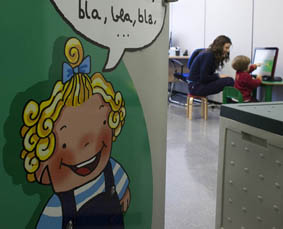
The University Centre of Diagnosis and First Aid (CUDAP), part of the General Foundation of the University of Valencia, has developed a new material, Visual Displays, to help children with autism or other issues to plan tasks and anticipate what will happen. This educational method prevents children with ASD (Autism Spectrum Disorder) from anxiety crises of insecurity that comes with the ignorance of the future.
This material, developed initially for a temporary work concept in children between 2 and 7 years with ASD, lack of attention or other cognitive difficulties, is the fruit of a collaboration agreement between the University of Valencia, through the CUDAP, the Toy Technological Institute (AIJU) and Miniland Educational Company.
The CUDAP, which currently provides care to 72 families, provided the scientific specifications for the Visual Displays, a panel system manufactured in plastic materials and adapted for wall (10x10 centimeters) and desktop (5x5 centimeters). This is a totally new material in Spain, nonexistent until now, based on the manual production of the panels by professionals working with children with any kind of difficulty.
"It is a task organizer, a planner, which consists of two parts: the base, placed on the table or on the wall, and the support of the image which fits into the base. You can chain pieces together in columns or rows and can put any image inside the support for this purpose, from a pictogram of SPC to real photographs of the child and their family or providing the same product with different tasks: physical education, lunch, queuing, meeting, farewell, reading, listening, etc.," explains the director of CUDAP, Francisco Alcantud.
A game for all children
Among the various advantages offered by Visual Diplays is the ability to be used both by professionals in specialized centers and by families at home. Furthermore, even though its development is due to the need to work the concept of time with children with autism, this product is accessible for any child. "You do not need to have a problem, any child, any school, anywhere there can be a Visual Diplays to help small maturation process," says Alcantud.
In this sense, from the Technical Unit of Child Consumption, Leisure and Recreation of the AIJU, Encarna Torres notes that Visual Displays "are not a unique material for a particular problem or for children with special needs, but for the use of all." "Its originality is that it allows work to acquire the notion of time, an abstract and difficult concept to grasp for children. In short, it allows them to touch time" he argues.
To carry out the final development of this system, AIJU carried out a national and international documentary study in which it was found that this material had not yet been scientifically designed. It also surveyed a hundred of teachers to confirm their viability in the classroom. "It's a growing line that is open to the suggestions of professional education. This concept simply emerges from daily experience and we want to continue to develop with the input of teachers," says Torres.
Last update: 16 de may de 2013 13:21.
News release



















